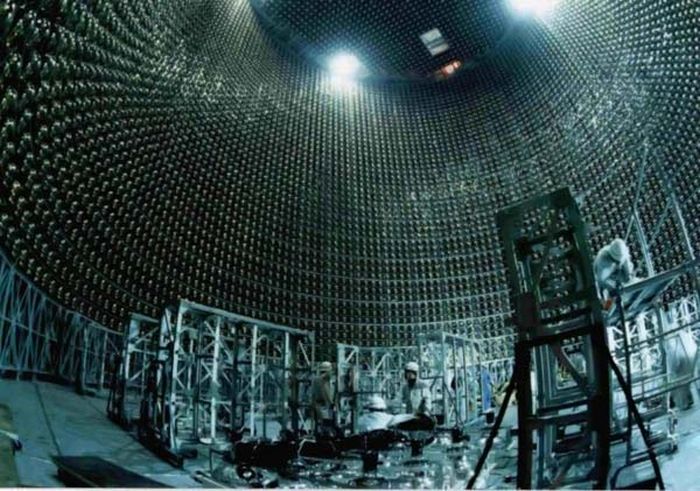|
|
Super-Kamiokande, Mount Kamioka, Hida, Gifu Prefecture, Japan
|
The detector, named KamiokaNDE for Kamioka Nucleon Decay Experiment, was a tank 16.0 m (52 ft) in height and 15.6 m (51.2 ft) in width, containing 3,048 metric tons (3,000 tons) of pure water and about 1,000 photomultiplier tubes (PMTs) attached to its inner surface. The detector was upgraded, starting in 1985, to allow it to observe solar neutrinos. As a result, the detector (KamiokaNDE-II) had become sensitive enough to detect neutrinos from SN 1987A, a supernova which was observed in the Large Magellanic Cloud in February 1987, and to observe solar neutrinos in 1988. The ability of the Kamiokande experiment to observe the direction of electrons produced in solar neutrino interactions allowed experimenters to directly demonstrate for the first time that the sun was a source of neutrinos.
Despite successes in neutrino astronomy and neutrino astrophysics, Kamiokande did not achieve its primary goal, the detection of proton decay. Higher sensitivity was also necessary to obtain high statistical confidence in its results. This led to the construction of Super-Kamiokande, with fifteen times the water and ten times as many PMTs as Kamiokande. Super-Kamiokande started operation in 1996.
The Super-Kamiokande Collaboration announced the first evidence of neutrino oscillation in 1998. This was the first experimental observation supporting the theory that the neutrino has non-zero mass, a possibility that theorists had speculated about for years.
On November 12, 2001, about 6,600 of the photomultiplier tubes (costing about $3000 each ) in the Super-Kamiokande detector imploded, apparently in a chain reaction or cascade failure, as the shock wave from the concussion of each imploding tube cracked its neighbours. The detector was partially restored by redistributing the photomultiplier tubes which did not implode, and by adding protective acrylic shells that are hoped will prevent another chain reaction from recurring (Super-Kamiokande-II).
|
|









